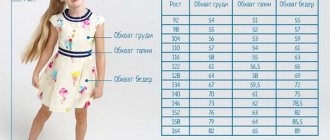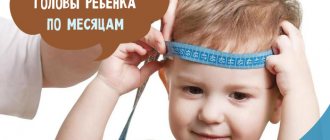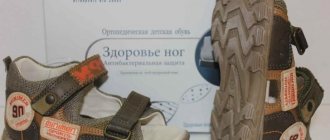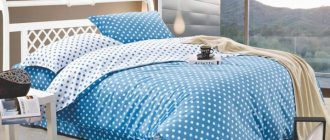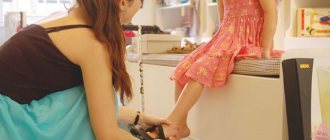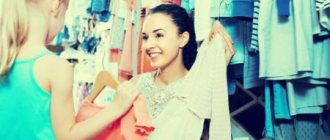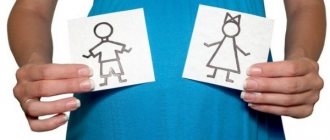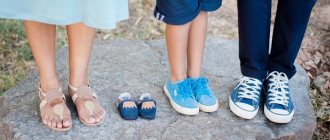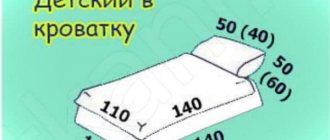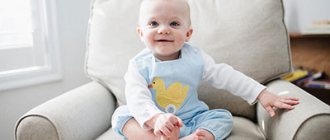Newborn headdress
The first hat a newborn wears is called a cap.
The material from which it is made must be natural, usually cotton. In hot weather, it breathes and prevents the baby from sweating; in cold weather, it effectively retains heat, protecting the baby from freezing. Caps are often made with wool or silk content. Manufacturers of children's clothing offer a large number of styles and colors. Additional Information. In addition to the fact that the cap warms the baby, it creates additional protection for the baby's fontanelle, which remains open for some time. It closes completely by the year. Until this time, the appearance of the fontanelle is one of the main indicators of the baby’s health. Pediatricians always feel it during examinations.
Caps for newborns
If the baby is discharged from the hospital in cold weather, you must first ensure that the child is warm and comfortable. While many parents try to dress their baby so that he looks better in photographs. Nowadays it is fashionable to organize photo sessions for newborns. When creating images of girls, elastic bands and headbands are used. They also need to be carefully selected so that they do not put too much pressure on the child and are made without the use of synthetic materials.
Features of hats for newborns
If the hat has buttons or other fasteners, you need to make sure that they will not put pressure or injure the baby’s delicate skin.
Note! There should be no rough seams or labels inside that cause inconvenience. Typically, baby clothes have seams on the outside. When they are inside, you need to make sure they are safe.
If the hat has ties and fasteners at the back, then it is better to abandon it. Newborns sleep a lot, outside almost all the time in a stroller. Therefore, the mechanisms at the back will cause discomfort. When there are appliqué elements on the hat, you need to pay attention to where they are located, whether they will interfere with the baby’s ability to sit comfortably in the stroller. Until three months, it is better to wear simple hats for the baby, without additional elements for beauty. At this time, the child's main concern is comfort. Patterns, rhinestones, bows are made exclusively for parents to attract their attention. They do not affect the quality and properties of the headdress.
If the hat is made of wool, which will prick the baby's skin, you should wear a thin cotton cap underneath. The main thing is to ensure comfort. If the material from which the headdress is made is natural, it will allow the child’s skin to breathe. It should be soft and pleasant to the body. It is better for the hat to be elastic and stretch when necessary. When your baby is indoors, you can use a larger hat.
The simpler the headdress, the better. It should not interfere with the baby’s movements or hamper them. There is no need to buy a lot of hats. Babies grow very quickly and hats become small.
When children spin around and act up, their hats move and may fall off. That's why many have soft elastic bands sewn into them along the edges. Other hats have ties. In this case, you need to carefully ensure that they do not injure the baby’s skin or restrict movement. It is better to use such hats in strong winds. Children don't really like these types of hats.
Baby in a hat with strings
Size chart for children: how to take the correct measurements
Any clothing, including knitted ones, should be, first of all, comfortable. First of all, this applies to children's things. Children are very spontaneous; they will not want to remain silent and pretend that they are comfortable in clothes if the item is not the right size and is loose or tight. To avoid this situation, it is important to know exactly the size of your child and knit the product in accordance with the actual measurements. In magazines, ready-made descriptions are sometimes limited to indicating the size of the item. In this case, you need to know what parameters correspond to this size. In addition, there is a difference in the designations of Russian and European sizes.
The corresponding size table for children, tips for correctly measuring the defining quantities are presented in this article.
For ready-made models, compliance with the Russian size of the sizes indicated according to the standards of different countries is presented in the table. The European system considers the child’s height to be the most informative and primary parameter. On the one hand, this greatly simplifies the choice, but on the other hand, it can be very disappointing. By choosing a model for knitting, focusing only on the specified height, you can end up with a product that is not suitable for other parameters. And this can happen even if, in addition to height, the age of your child indicated in the table also coincides.
The problem is that every child's body shape is different. Plump, thin, with long arms, with a wide back... And in the process of growth, each child develops its own peculiarities of body structure. Therefore, this table is suitable for a first, rough estimate of the model size.
In order to more carefully study the compliance of the selected pattern with the parameters of your baby, an assessment of several more parameters is required. Their average values, related to the age, height and weight of the child, are used by global manufacturers of children's clothing.
Please refer to the chart below to determine your child's size correctly. It shows the basic measurements used in the manufacture of clothing. She will help you navigate by knowing the age, height or weight of the child.
You can choose your clothing size even more accurately if you take into account gender differences. The chest and hip circumference of girls and boys under 6 years of age does not differ significantly. But after 6 or 7 years, structural features of the female and male figure begin to appear. We provide tables of basic measurements for boys and girls from 7 to 14 years old.
To assess compliance, you will need to take the measurements indicated in the table and compare them with the actual ones. The following illustration shows where to take measurements correctly.
The content of the article:
How to take measurements
One of the main requirements when taking measurements is that the child must stand freely, without tension, with his arms at his sides and his heels together. We measure babies in diapers or absorbent panties, older children in underwear. Teenage girls should wear a bra. If it is not possible to measure the child, you can perform such measurements on his things. You need to choose wardrobe items that are ideal for the baby. Below we have listed the most necessary measurements that will help you knit any item for a children's wardrobe.
Height
You need to start measuring with this parameter. For children under two years of age, such measurements should be taken in a supine position using a measuring tape or a long ruler. We measure height from heels to crown.
For a child over two years old, we measure height in an upright position. You can do this with a special stadiometer, or you can put the baby near the door and, making a mark at the level of the top of the head, measure the height from the floor with a centimeter tape.
Waist circumference
For ease of measurement, it is recommended to tie a narrow belt or any non-stretchable tape along the waist line. It will serve as a level marker during measurements.
We measure the girth at the thinnest point. If you ask your child to move - sit down, bend over, walk around - the belt will automatically move to the waist and mark it. It is clear that the belt should be tied tightly, but not tightly. At the same time, you need to pay attention so that the “model” does not suck in her tummy, trying to be more graceful.
Hip girth
We pass along the widest place, including along the protrusions of the buttocks and thighs, capturing the bulge of the abdomen.
Bust volume
We measure this parameter under the arms, through the protruding points of the chest and shoulder blades.
Back length
To do this, ask the child to tilt his head forward. This will help you find the seventh cervical vertebra as the most prominent one in the neck. The length of the back is measured from it to the belt at the waist.
Armhole length
Distance from the top point on the shoulder to the chest measurement line. The measuring tape should be kept strictly vertical.
The length of the sleeve
We measure from the base of the shoulder to the end of the thumb on a slightly bent arm along its outer side through the elbow.
Length trousers
The length of the trousers (not to be confused with the crotch!) is measured from the side (along the virtual side seam) from the waist to the ankle bone.
Crotch seam
We measure from the groin to the ankle.
Skirt length
Similarly, the length of trousers is measured along the side from the waist to the desired length of the product.
Hip circumference
We measure under the groin at the widest point of the upper leg.
Neck circumference
We measure approximately one and a half cm above the junction of the shoulders and the neck - under the 7th cervical vertebra and the jugular fossa. You will definitely need this size when determining the rollout depth of the product.
Head circumference
We measure along the line of the middle of the forehead.
If you are knitting a children's swimsuit or other clothing that requires a fairly tight fit, then you cannot use the previous tables. For such models, it is better to use sizes for children's underwear.
Important Note
When choosing the size of the item to knit, keep in mind that newborns grow especially quickly, adding size every month.
From 3 months to one year of age, an increase in size occurs approximately every three months. From 1 year to 4 years, such an increase occurs in six months. Older children grow one size per year. Therefore, consider how long you will knit a new thing, how long you plan to wear it, and decide on the size. Otherwise, it may turn out that a cute little sandpiper, knitted in advance in winter, is not at all suitable for the baby in the summer season. Now let’s take a closer look at the size tables for children’s hats, mittens and socks.
How to correctly take measurements from a child: MK video
Children's hat size charts
To select the correct headgear, you need to measure the circumference of your head and the depth of the hat. This need is due to the fact that the shape of the skull is different for all people and a guideline based on age does not always guarantee an ideal match. Therefore, a cap that is suitable in volume may be short, leaving the ears or back of the neck exposed.
To measure, wrap a measuring tape around your head at a distance of 1.5 - 2.0 cm above the level of the eyebrows, just above the ears and through the most protruding point on the back of the head. When measuring, the measuring tape should not be pulled tight, but it should not be loosened either. It is advisable to take several measurements to determine the best result. It should be used when knitting a hat.
For a winter hat, it is advisable to take additional measurements. To ensure that the hat fits snugly, we measure the length of the oval of the face to the cheekbones and the distance from one temporal cavity to the other.
If you are unable to take these measurements, please refer to the table below.
The topic of hat sizes for children under one year old requires special attention. Primarily because babies grow quickly and their head volume increases by about 1 cm every month. In addition, for boys and girls of this age, the head circumference is slightly, but different - see the table.
Hand sizes for knitting mittens and gloves
There are two main sizes - palm circumference and arm height.
Advice
Measurements should be taken on both palms, as sizes may vary. In this case, we select the larger result for calculation.
To measure arm circumference, ask your child to raise his arm as if he is about to wave to someone.
The fingers should not be clenched, but in a normal straightened state. We measure across the palm below the little finger and above the thumb. In children, this number is usually from 3cm to 15cm, depending on age.
We measure the height from the end of the middle finger to the base of the palm.
For knitting children's mittens using ready-made models, a summary table of sizes can be useful.
When doing your own calculations, the following two tables will be useful.
Size charts for knitting children's shoes and socks
Booties
To determine the size of the booties, you need to measure the baby's foot in length and width. Width is measured at the middle of the sole. The difference between these two sizes is equal to the length of the original chain of VP.
It is convenient for newborns to take measurements while sleeping. To do this, we outline the outline of the leg in a thin sock and measure it from the tip of the big toe to the heel along the foot.
An approximate table for orientation - see below.
The sizes of finished models of booties are designated differently. We present various options.
Socks
To knit socks you will need the same foot measurements as for booties. For an approximate calculation, the size table will be useful to you.
A more detailed calculation taking into account all sizes can be found in the tables below.
Table No. 1 – for knitting with fine yarn (50g per 200m, knitting needles No. 2.5)
Table No. 2 – for knitting with yarn of medium thickness (50 g per 150 m, with knitting needles No. 3)
Similar articles
We recommend reading:
vjazanie.info
The importance of headdress
With the birth of a baby, parents have a lot of worries regarding clothing. After all, it is impossible to try it on, so you need to know the size. Mothers are usually inexperienced in this matter, which is why many manufacturers simply indicate the age on the label, which greatly simplifies the purchasing process. But if with clothes it’s a little easier, then with a headdress everything is different. Of course, there are sizes of children's hats according to age, but each child has his own head size. Therefore, you need to choose especially carefully. In winter, it is very dangerous for a baby to get a cold in the head, and in summer it needs to be hidden from the hot sun. Therefore, the headdress should not squeeze the head or, conversely, creep into the eyes
Terminology and types of hats
You may be surprised, but there is a whole “Big Dictionary of Headdresses”, a significant part of which is still in use. Even the seemingly simplest caps or berets have dozens of options and sub-options. It’s difficult to understand all this in detail, and it’s not worth it. Let's just try to highlight the main types of children's hats in order, firstly, to navigate their endless variety, and secondly, to simplify our life when searching for and choosing a hat in an online store.
A cap
The constant leader is the hat, a collective term that in the vast majority of cases means a traditional headdress with a more or less loose cut. It may vary the material, the thickness of the fabric, the design may change slightly (for example, the presence or absence of a pom-pom), but the general features are almost always the same and upon request “boys hat” you will receive a set of items of approximately the same style.
A classic hat without restrictions may contain various prints, patterns, ties, buttons, rhinestones... Of course, a coarse knitted children's hat with a pompom looks a little different than a finely knitted model with patterns and rhinestones, but nevertheless, both options are a hat, aka hat.
Beanie
A beanie hat that fits tightly to the head was once the privilege of working people, athletes, and climbers. But this practical model was quickly appreciated by young people, always hungry for fresh ideas, and then everyone else caught up.
The origin of the term is still debated, ranging between the French "bejaunus" (yellowmouth) and the English "bean" (bean). Despite the simplicity of the design, the beanie is fashionable, fresh and practical, because one of the advantages of the traditional beanie hat is the fact that it takes up extremely little space - no more than a sock, and will fit into any pocket or even pocket.
Baseball cap
Oddly enough, the baseball cap actually has a direct connection with the truly American sport of baseball. In the 50s of the last century, this sports cap with a characteristic visor that protected the players’ eyes from the sun was introduced as an accessory and element of the baseball player’s uniform. Almost immediately, fans acquired similar models, and very quickly the baseball cap ceased to be exclusively a sports headdress.
We recommend reading: Rating of safe, best children's toothpastes
Everyone liked the design, and when it turned out that various designs could be applied to a baseball cap, a real epidemic began. After all, these caps have become advertising products - along with keychains and pens. Now there are so many options that even a winter insulated baseball cap with natural fur won’t really surprise anyone.
Panama
The straw hat, which gave this headdress its name, is almost no longer associated with it. But, seeing the familiar narrow brim and thick fabric, “Panama hat” (or “Panama hat”, depending on your taste) immediately comes to mind. In fact, what we used to call a Panama hat is the so-called “bucket”, or bucket hat.
The “bucket” was invented by British farmers at the beginning of the 20th century. Then it became popular among fishermen who appreciated the convenience and comfort. As a fashion accessory, the headdress began its journey after the Vietnam War, where it was part of the equipment of American soldiers.
The model’s convenience, comfort and stable demand have led to the fact that the “bucket” Panama hat is invariably present in the catalogs of almost all fashion brands. Well, a children's Panama hat is an accessory that you can't do without on any summer walk.
Material
When choosing a children's hat, preference, of course, should be given to natural fabrics. Polyamide, acrylic and other synthetics can only boast of durability and low cost. But ideally it can be present only as a small percentage in the form of elastane, to give shape. A synthetic hat will not bring any comfort either in winter (it is simply cold) or in summer (in fact, it is a plastic bag on the head).
Therefore, only cotton and wool, and of good quality. Silk is added to fabric very rarely, and even then only in the case of expensive hats from various pretentious brands, so it is rather exotic.
Care
If washing is necessary, you must carefully study the information label inside the product. Cotton hats can be washed without any problems at 30 degrees in an automatic washing machine. However, it is worth remembering to choose a short program (30-40 minutes), and the spin speed should be as low as possible. Wool is washed only on a special gentle cycle in cold water.
You cannot spin woolen items in automatic mode at all. It’s a good idea to follow the rule “wash dark with dark, and light with light,” and good laundry detergents won’t hurt either. You shouldn’t overuse laundry detergents; the formula “the more the better” definitely doesn’t work here: excess detergent will affect the color and condition of the headdress. Add exactly the recommended amount of powder or even less than specified.
For good woolen hats, which are not cheap, manufacturers, to play it safe, recommend exclusively dry cleaning as care. Even so, a gentle hand wash in cold water and mild soap won't hurt.
The advantage of synthetic hats, in addition to the low price, is durability. They can be washed at least every day.
Features of choosing a hat/cap for newborns
Above are the sizes of children's hats, average for the indicated periods of life. And if we are talking about buying knitted or knitted products for babies over one year old, then more precision is not required here. Elastic fabric is good: it fits without unnecessary pressure and stretches when necessary.
All important information from this article is in the files, you can print or download it:
The head size of newborns is determined by month (boy/girl) and circumference. Or rather, primarily around the circumference. It is no coincidence that we focus on this: a hat that is too loose can move and interfere with the free breathing of an infant, and a hat that is too tight can cause discomfort, causing crying. In addition, during a walk, children's ears will not be sufficiently protected from the wind.
The step of one hat size for a newborn in the table (boy/girl) is 3 months. You should take this as a starting point when buying a cap for discharge or for constant wear. We take it according to the age at the moment, but we can wear it for 2-3 months. According to this principle, you can purchase several products at once in order to replace what has become scarce.
| Marking | Months, years | Head circumference cm | Height cm |
| 35 | 35 | 50-54 | |
| 40 | 3 | 40 | 56-62 |
| 44 | 6 | 44 | 62-68 |
| 46 | 9 | 46 | 68-74 |
| 47 | 12 | 47 | 74-80 |
| 48 | 1.5 g. | 48 | 80-86 |
| 49 | 2 years | 49 | 86-92 |
Please note: the sizes of children's hats in the table correspond to head circumference. This is what you need to start from when choosing a thing. However, the product label will most likely have double markings, as at the beginning of the article: 34-39, 37-41, 39-43, etc. This is the minimum and maximum volume within the range of which your baby’s parameters should fit.
Useful information on the topic:
- A child’s head grows most actively in the first 3 months of life (1.5-2 cm each). During this period, hats will have to be changed most often.
- By the year, the maximum increase will be 1 cm in 30 days.
- From 2 to 10 years, growth slows down, at most by 5 mm. in 30 days. This is well reflected in the sizing chart above.
- Winter products, if you plan to wear a bottom layer underneath, purchase 1 order more.
- Everything that is bad or does not stretch at all - we choose at what age, as accurately as possible, we avoid the options “butt” and “for growth”.
The purpose of the cap also plays a huge role:
- For the street. These hats must be reliable, especially in the cold and mid-season.
- For home. Such a hat should, first of all, be comfortable - the baby spends most of his time at home.
- After swimming. Such a product should absorb moisture well - the child’s head is wet after a bath. In addition, it should have ties and be quite thick, ideally good cotton. This will protect the baby’s crown and ears in case of an uninvited draft.
It is important to take into account the age characteristics of the child. Children under 6-8 months mostly sleep during walks, so stripes and pom-poms on their hats are undesirable. One-year-old children love to take off their hat while walking, it is better if it has ties. But for older kids, a hat with ears or pompoms will only be a joy.
We recommend reading: Advantages and disadvantages of the best bottle warmers
Determining the right size: main nuances
The size of the cap depends on the length of the head circumference, measured in centimeters.
Very often there are products for children indicating only the age of the child. However, not all children have the same development; because of this, their parameters differ significantly. It is for this reason that height alone is not enough to select the right hat.
The size numbering system includes even numbers (44,46,48). There are also double children's sizes (44-46, 46-48).
If the head circumference is between two values, then when buying a summer cap or cap for your baby, choose the one that is smaller, because the fabric from which they are sewn has the ability to stretch. It is better to buy a winter or demi-season headdress one size larger, since a lighter hat is most often worn under it.
It is worth taking the procedure of selecting a hat for a child very seriously. This is especially true for accessories for newborns. A large hat size can be dangerous for a baby, because... Newborns move their head very often, and it can slide down, covering his face, causing difficulty in breathing for the baby. A winter hat of the wrong size can cause your baby to get frequent colds due to the fact that it will let in cold air.
A small headdress will create discomfort for the baby. What could make his health worse?
To determine the correct size, you must first measure your child. When choosing a hat, you need to use the so-called “reference point” - this is the circumference of the head of a six-month-old child. On average, this value is 43 cm. To determine the size for previous months, you need to subtract one and a half centimeters from this indicator for each month. To determine the size for a child who is more than six months old, it is necessary to add 0.5 centimeters to the “reference point”.
During the first year of a child’s life, the size of his head increases by 11.5 cm. During the first six months, growth occurs more intensively. During this period, the head grows by 8-9 cm. Up to 4 months, the head circumference is larger than the chest circumference. Every month there is an increase of 2 cm. At the age of one year, the head circumference is 48 cm. The gender of the child also affects the size of the head. Boys have larger heads.
Finding out the parameters of the headdress
Now we will give some tips regarding what size cap to buy for a newborn or older child. First of all, we must find out the head circumference of our “client”. We measure it with a measuring tape, drawing it slightly above the eyebrows and along the highest part of the back of the head. We don’t tighten it too much, but we also don’t let it sag. Next, we turn to the numbers above and see which line the resulting numbers match.
A complete classification of types of fabrics is on our website; compare natural and artificial materials.
And one more small clarification. In this article we talked about Russian markings. However, there are products on sale with letter markings. How to determine the size of a children's hat in this case? Let's just check this sign.
| Head circumference | 40-43 | 44-46 | 47-49 | 50-52 | 53-55 | 56-58 |
| Number of months, years | 3 months | 6-9 months | 12-24 months | 3 years | 4-5 l. | 10-12 l. |
| Marking | XXS | XS | S | M | L | XL |
How to correctly determine the size of a hat for women and children (in centimeters)
The abundance of characteristics may be a little confusing for many, but the majority of hat manufacturers focus not only on the dependence of head circumference on the child’s age, but also on his height. When using so many parameters, the chance of choosing a headdress that will definitely fit increases.
Many manufacturers, in order to make things easier for parents, write on the labels not only the size of the product, but also the age category for which it is designed.
Unlike children's size charts, size charts for adults do not contain age information. The sizes themselves are usually designated by standard letters: L, M, XL, XXL and so on. When choosing a headdress for a woman, a number of features should be taken into account. Firstly, many representatives of the fair sex like to wear voluminous hairstyles, which cannot be pressed too tightly to the head with a beret or hat, so as not to spoil it.
For lovers of full hair, be sure to add 1 cm to the head circumference and choose looser styles. The range of hats for women is impressive in variety. The presence of ribbons, laces or other devices designed for slight changes in size should also be taken into account when choosing a headdress. This option is perfect if the product stretches.
Main characteristics of hats
Hats have the following characteristics:
- Diameter.
- Size.
- Girth.
- Depth.
To determine the size of the hat, you need to take into account only one indicator: head circumference. Measuring it yourself is quite simple. To do this, you only need a measuring tape, which is what tailors use for their work.
How to measure: Apply the tape to the head 1 cm above the level of the eyebrows and tips of the ears, wrap it around the head and bring both ends together at the crown.
Next, the received data needs to be checked against the size table (grid) and you can safely order your hats in absentia. If you don’t have a measuring tape at hand, you can use a regular ruler and thread. The thread is wrapped around the head according to the instructions above, then it is applied to a ruler and the exact length of the thread is determined in centimeters.
Children's hat size chart
European and international hat sizes
Factors to consider
The size of the headdress is influenced by three characteristics:
- The material from which it is made.
- Pattern, if available
- Product density.
Woolen or cotton products tend to “shrink” over time, while viscose, on the contrary, stretches. When choosing a hat, the features of the material must be taken into account so as not to throw away a product that has stretched or, conversely, shrunk.
Winter hats should fit tightly around the head, so when choosing a headdress for the cold season, be sure to subtract 1 cm from the circumference of the head. This is the same “reserve”, thanks to which the hat will not slip or dangle. But there are several rather important nuances.
Quite a long time ago, hats with voluminous patterns came into fashion. The very first were the famous “braids”, which still remain at the top of popularity. When choosing a hat with embossed, “heavy” patterns, you need to subtract at least 1 cm from the head circumference, because such a product will stretch a little over time and will “hang” on its already very unhappy owner.
How to correctly measure the volume of a child's head
How to determine your hat size
The density of the hat also affects the size of the product. If the material or knitting is “loose” and voluminous, then when selecting such hats you should subtract at least 1 cm from the circumference of the head.
Well, as always, here’s a video to help you on how to determine your hat size:
Determining the size of a children's hat
First of all, we need to determine the circumference of the head:
- take a measuring tape; if you don’t have it, any rope or tape will do;
- if you still have a baby, place him on a flat horizontal surface to make it easier to take measurements;
- we draw it around the head above the eyebrows and ears, always along the most convex part of the back of the head;
- ready! If you used rope, then you will have to measure the resulting length with any ruler.
Round the resulting number down, because the cap should fit tightly, and it can stretch over time.
In addition to head circumference, you will need height, we are sure you already know it.
How to measure your head size for a hat?
To knit a knitted product that fits your size, you should definitely know the volume of your head . Such parameters will allow you to make correct calculations in the loops , so that the cap, for example, is not too small or too large.
The size of the head, like the whole body, is measured in centimeters. This can be done in two proven ways:
- Using a special centimeter for a tailor (“tailor’s centimeter”). It is very simple to use: determine the middle of the forehead, fix the point with your fingers and wrap the centimeter around your head. The soft material of a professional measuring tape will take any given shape and clearly show you the value. Keep in mind that you should add one or two centimeters to the result obtained so that the knitted product is not tight.
- Using a regular ruler and thread. This method is suitable for those who do not have a professional centimeter at hand. To do this, you should take absolutely any thread and, according to the principle described in the previous tip, wrap your head. The thread is fixed or cut when it is completely closed. The cut piece of thread should be measured with a regular ruler on a flat surface. You should also add one or two centimeters to the measured value when knitting.
Measuring a child's head with a tailor's centimeter
How to easily measure the volume of a child's head?
Scheme for taking head measurements for a hat
Size chart for children's hats for knitting
A size chart for children's hats, focused on knitting, allows each needlewoman to calculate the exact number of loops intended for a certain age.
Such a table should give four main parameters:
- Children's head volume
- Diameter of the “bottom” of the cap
- Cap depth
- Estimated age of the child
Scheme for calculating hat sizes
Size chart for children's knitting hats
Tips “just in case of fire”
If you are in a store and have already looked at the desired accessory: a beret, a hat or another headdress, then, of course, you need to try on this product before purchasing. But what if you didn’t take your child with you when shopping? You don’t want to make a mistake by choosing the wrong hat size for children’s hats.
In this case, use one of two methods for calculating the size of the hat:
1) you need to fold the cap flat, close its edges and measure using a ruler. The resulting value is multiplied by two, and another centimeter is added to the result. The total number of centimeters is the estimated volume of the child's head;
2) look for an indication of the size of the hat on the headdress. This information is usually left on a label on the outside or inside of the product. It happens that the exact volume is indicated in centimeters, and sometimes it is a simple designation. For example, "2M" means two months.
If you are knitting a hat for your child or are going to buy him a ready-made high-quality product, then it is very important to know the parameters and volume of your child’s head. We hope that the tips and sign from this article will help you correctly calculate the parameters of a children's headdress.
Hat sizes by age
It is believed that each age has its own size. And some sellers only indicate age. But all children are different, therefore, you should also focus on height. We suggest you choose a hat for your child according to age and height according to the table.
Sizes of hats for children table
| Hat size | Head circumference | Height | Age |
| 35 | 35 cm. | 50-54 cm. | newborn |
| 40 | 40 cm. | 56-62 cm. | 3 months |
| 44 | 44 cm. | 62-68 cm. | 6 months |
| 46 | 46 cm. | 68-74 cm. | 9 months |
| 47 | 47 cm. | 74-80 cm. | 12 months |
| 48 | 48 cm. | 80-86 cm. | 1.5 years |
| 49 | 49 cm. | 86-92 cm. | 2 years |
| 50 | 50 cm. | 92-98 cm. | 3 years |
| 51 | 51 cm. | 98-104 cm. | 4 years |
| 52 | 52 cm. | 104-110 cm. | 5 years |
| 53 | 53 cm. | 110-116 cm. | 6 years |
| 54 | 54 cm. | 116-122 cm. | 7 years |
| 55 | 55 cm. | 122-128 cm. | 8 years |
| 56 | 56 cm. | 128-134 cm. | 9 years |
| 56 | 56 cm. | 134-140 cm. | 10 years |
| 56-57 | 57 cm. | 140-146 cm. | 11 years |
| 56-58 | 58 | 146-152 | 12 years |
You may often come across a standard in which 2 numbers are indicated, for example, “44-46” or “48-50”. We advise you to use a smaller number for a summer headdress and a larger number for a winter one.
When choosing a winter hat for a newborn, give preference to a larger size, because you will wear a cap under it.
How to determine what head size your child will have
To determine the size of children's hats and bonnets according to the child's age, we provide tables below that correspond to the age and size of hats and bonnets. The size of the headdress based on head circumference is given based on the average for Russian children. Interestingly, in the first three months, the circumference of a child’s head increases by an average of 2 cm per month. Then, from three months to one year, the child’s head increases by 0.5-1 cm per month. Later, head growth slows down even more. By the age of two, the circumference of a child’s head increases by an average of 2.5 cm. And from two to 10 years, a child’s head grows only 0.5 cm per year. Boys have larger heads.
We provide tables of sizes of hats and bonnets separately for boys and girls.
| Size chart for children's hats and caps for boys |
| Boys age | 0 months | 1 month | 2 months | 3 months | 6 months | 9 months |
| The average size | 34-39 | 37-41 | 39-43 | 41-45 | 43-47 | 45-48 |
| Boys age | 1 year | 1.5 years | 2 years | 3 years | 4 years | 5 years |
| The average size | 47-49 | 48-50 | 48-51 | 49-52 | 50-53 | 50-54 |
| Boys age | 6 years | 7 years | 8 years | 9-10 years | 11-12 years old | 13-14 years old |
| The average size | 52-54 | 52-55 | 52-55 | 53-56 | 54-57 | 54-58 |
| Size chart for children's hats and caps for girls |
| Girls age | 0 months | 1 month | 2 months | 3 months | 6 months | 9 months |
| The average size | 32-38 | 35-40 | 37-42 | 39-44 | 41-46 | 43-47 |
| Girls age | 1 year | 1.5 years | 2 years | 3 years | 4 years | 5 years |
| The average size | 45-48 | 47-49 | 48-50 | 49-51 | 50-52 | 50-53 |
| Girls age | 6 years | 7 years | 8 years | 9-10 years | 11-12 years old | 13-14 years old |
| The average size | 51-53 | 51-53 | 51-54 | 52-54 | 52-55 | 52-55 |
A newborn baby constantly outgrows the caps, because they are cotton knitted and have almost no stretch. If the cap is small or large, then the style of the cap itself forces the mother to put on a cap that is the right size for the child and change it to a larger one in time.
Another thing is hats for winter, spring and autumn. The newborn will definitely outgrow his first hat, but next season’s hat, perhaps, if it stretches a little, he will be able to wear in a year. In the first three years of a child’s life, one winter hat will probably be enough for two winters, and a child will definitely wear a demi-season hat through spring and autumn and, perhaps, into a third season.
How to choose a hat for a newborn
Be sure to dress your baby according to the weather. Remember that overheating for newborns and babies up to one year is much more dangerous than freezing. Thermal regulation in babies is not fully developed; in conditions where an adult would be cold, the baby may find it comfortable. Therefore, you need to monitor the baby’s condition very carefully. If your head under the hat is sweaty, you need to replace it with a thinner one that is not insulated. When a wet child goes outside, there is a high chance that he will get sick. Colds develop very quickly in children. Therefore, it is easier to prevent them than to treat them.
In the first months of life, the baby always walks with a hat. Even in hot weather it is necessary to protect from the sun. In such cases, you can purchase a hat that will protect your eyes from scorching rays. A hat is an important element of your wardrobe; you need to be careful when purchasing it.
Choosing a headdress by season
For your baby, you need to purchase a thin knitted hat, which the newborn will wear indoors, and a headdress for outdoors. The choice depends on the time of year when the baby was born. In summer, it is enough to use a thin hat. If it's cold in the evening, you can wear a fleece hat. In such a hat, a small person will be protected from the wind and will not freeze.
Important! Fleece material is not natural, so you need to watch the baby’s reaction: for allergies or skin irritation. You can purchase an openwork headdress made of yarn. Their styles and colors are varied.
In spring and autumn you can use:
- knitted;
- terry hats.
We recommend reading: What to give your wife for the birth of a child: Gift ideas + Photo of the gift
Comfortable hats with ears and ties. Such a hat will not move or jump off and will protect the baby well. In strong winds, you can use a hood. It would be better if it could be unfastened so that you can put it away when not needed. Otherwise, it will disturb the baby when he is resting in the stroller.
A hat for winter should be chosen especially responsibly: ensure that it covers the baby’s forehead, ears, and throat. There are helmet hats that leave only the baby’s face exposed and also cover part of the cheeks. When using them, there is no need to tie a scarf; they cover your neck. They are also very easy to put on, usually using a button. For older children, after one year, similar hats are worn over the head. There is no need to be afraid to purchase such hats; they are very convenient to use.
Typically, warm hats are made with a knitted or fleece lining. If it is not there, you need to wear an additional thin cap. This is especially necessary if the warm one is made of knitted fabric. Knitted winter hats stretch well, so young mothers prefer them. This property will help you carry the hat throughout the season. The baby's head grows, and within a month the circumference increases by one centimeter or a little more. Fleece hats are also popular in winter, but they are not as flexible. There is a chance that you will have to buy a new one.
Baby winter hat
It is better to buy hats from trusted brands and manufacturers to be sure that the hat will not fade or shrink after washing and will not lose its properties. The best choice can be made by reading reviews on the Internet and talking with consultants in children's stores.
Nuances of choice
When choosing, the age of your child is important, since the rate of increase in head circumference depends on it and a new headdress can very quickly become tight.
The list will help you navigate:
- newborn - 3 months - increases by about 2 centimeters per month;
- from 3 months to 1 year - increases from 0.5 to 1 centimeter per month;
- from 1 year to 2 years - during this period the circumference increases by 2.5 centimeters in total;
- from 2 to 10 years – grows by about 0.5 centimeters every year.
When choosing a cap for your baby, do not choose one that is too large - it may fall on the face when turning the head and interfere with normal breathing.
Keep memories of your youth in your head. Agree that you were reluctant to wear a tight winter headdress, so don’t choose one that is too small.
Table for determining hat sizes - Three Hands - the world of exclusive things
“I think many knitters, especially beginners, face the same questions when knitting hats: how to determine the circumference of the head if the model is not nearby?
How to determine the depth of the cap? What diameter should the bottom be if we crochet starting from the crown? Of course, when the one for whom you are knitting is nearby and you can constantly try on, all these questions are not so relevant, but if you are knitting as a gift, to order, or preparing a trousseau for a baby who has not yet been born, then it would be nice to have hand a table that contains all this information.
I myself surfed the Internet a lot, collected scattered information, copied tables. which I came across, but they were all incomplete, inaccurate, I had to open the computer again and torment the search engine and needlewomen on the forums. Therefore, I decided to collect in one table all the information that will be needed for knitting a hat)
Let me explain all the positions: 1. Head circumference.
We take a tailor's centimeter and measure the head at the widest part (best at a distance of 1.5-2 cm above the eyebrows, just above the ears and at the point on the back of the head that gives the greatest circumference. It is better to do this several times so that it does not turn out to be what they knitted for my daughter, but it turned out for myself) 2. Bottom diameter.
We need to determine the diameter of the bottom if we crochet a hat starting from the top of the head. To do this, divide the head circumference by 3.14 (remember the math)) In order not to run to the calculator every time, I calculated everything in one fell swoop and entered the data into the table.
Attention!!! It should be taken into account that for a tight fit it is necessary to subtract 0.5-1.5 cm from the resulting figure.
A lot still depends here: 1) on the pattern - if you knit with single crochets, and such a knitting does not stretch at all, then you can not take anything away at all, if you knit with an openwork pattern, or with double crochets, then you can subtract about 1 cm; 2) on your knitting density - if you knit tightly, then you need to subtract less, and if it’s loose, then more; 3) from who you are knitting for , if it’s a child, then it’s better not to subtract too much from the number in the second column, since children’s heads are growing and it’s better to knit a little with a reserve so that you have enough for the season, and if you’re lucky, for the next one) For an adult, you can subtract 1 cm or more so that the hat fits tightly on the head. 4) from yarn - cotton can shrink a little after washing, just like wool, and acrylic and viscose can stretch; when calculating the diameter of the bottom, this must also be taken into account. 3. Cap depth , i.e.
the height of the resulting headdress. We measure with a centimeter from ear to ear, across the top of the head, divide by 2 and add 1-3 cm, depending on how much we want to cover the ears. If it is not possible to measure, then we focus on the table, but we must take into account that every rule has exceptions. Attention!!! The table shows the depth when unfolded; when put on it should be a little more. 4. Age.
Everything is clear here)) This column is exactly what you need to roughly estimate the dimensions if you cannot take measurements.
Author: Marina Getsevich (text from the author)
triruki.ru
DIY hat: knitting
While the expectant mother is waiting for the moment of the birth of little happiness, she may well knit a cap for him with her own hands. The dimensions of the finished product can be taken from the table above, taking into account the diameter of the bottom and the depth of the cap. We offer you a very simple hat model, but as a result you will get a cute and warm thing. The size is designed for babies aged 0 to 3 months, you will need 3 knitting needles and 50 g of baby wool yarn:
Cast on 44 loops.
- Knit the first purl and knit row with knit stitches.
- Knit the third row with purl stitches, and the fourth row with knit stitches.
- Continue the given sequence until you have 13 cm of knitting.
- Divide the stitches onto 2 needles, 22 each.
- Using the third knitting needle, knit the stitches on the right and left sides together. This way the hat will be seamless.
- To tie the hat, thread a lace or braid made of thread into the hole in the pattern on both sides of the hat.
Ready!
Useful tips
- When buying things for a child “in advance”, it is important to navigate the sizes of clothes for newborns. It is better to buy several things, including hats, which at first will turn out to be too big. The baby will grow up to them in any case.
- Measuring the baby's head circumference can only be done when the baby is awake and calm. Talk to the baby so that he is not afraid of the thread or centimeter.
- The head circumference table for children is approximate; all children grow differently. You can rely on it, but it still does not replace personal fitting.
- When choosing a hat for a baby under one year old, take into account the presence and roughness of the seams, the child’s comfort depends on this.
- If the child is already 2 years old, not only the size of the hat is important for him, but also its appearance. If the fidget doesn’t like the headdress, he will simply get rid of it.
- Do not buy hats in bright, catchy colors - over time they will begin to irritate the eye. Choose calm pastel colors or natural shades.
- For curious children, you should not buy hats with sequins, beads or decorative buttons - there is a chance that the baby will tear them off and put them in his mouth.
What to do if there is a foreign marking on the header
The designations on the labels of clothing from Europe and the USA differ from those indicated on Russian items. When purchasing hats in foreign boutiques and online stores, you should convert domestic sizes to foreign ones using a comparison table.
| Head circumference | Letter mark | England | France | USA |
| 47 | – | 5 | 0 | 5 7/8 |
| 49 | S/M | 6 | 1 | 6 1/8 |
| 51 | XXS | 6 1/4 | 2 | 6 |
| 53 | XS | 6 1/2 | 3 | 6 5/8 |
| 55 | S | 6 3/4 | 4 | 6 |
| 57 | M | 7 | 5 | 7 |
We also recommend the article: American clothing sizes in Russian (comparative tables).
